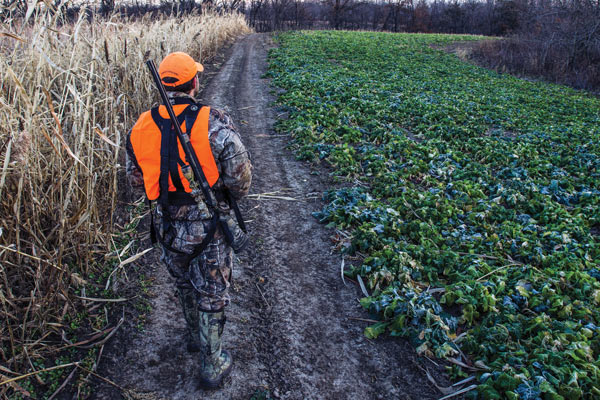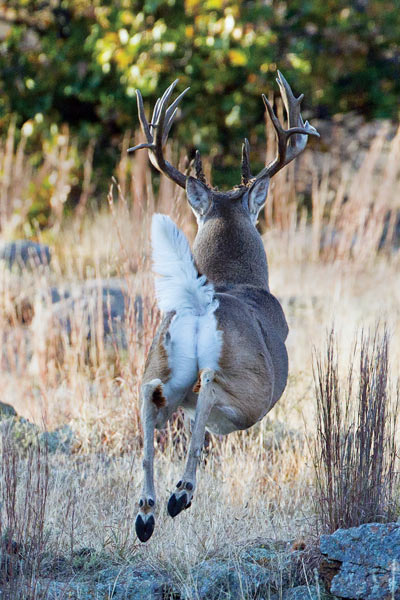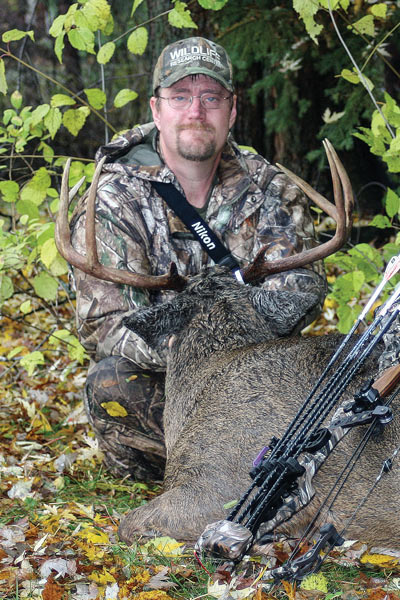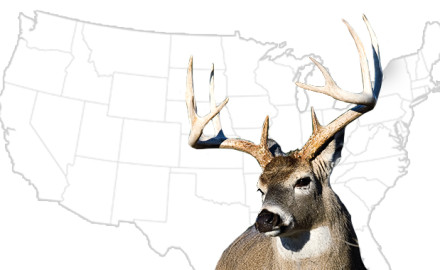
I had an opportunity, and I took it.
A friend was going to lease some ground near my home. Without a private piece to hunt myself, I offered to go in with him. Before I knew it, a turn of events resulted in my having it exclusively to myself.
And that was fine by me. The ground had the potential to offer everything I needed to eventually drag a great buck out of an area not known for producing them.
The decision on which piece of ground to buy or lease for hunting is a big one. Jump the wrong way and the climb out can be long, expensive and even fruitless. Because of that, it’s no surprise so many whitetail hunters often agonize over picking the “right” ground to lease or buy.
As a professional habitat consultant, I’ve seen a lot of variations on leasing/buying hunting land. With that in mind, what follows are considerations I find important when advising clients on whether a given property is the best fit for them.
If you’re looking to gain more control of your whitetail future by buying hunting ground, I’m confident these tips can help you, as well.

Defining Your Goals
It’s virtually impossible to build a property to meet your goals if you don’t at first define them.
The same principle applies to buying or leasing hunting ground. In this case, if you haven’t identified what you truly want out of the acreage, who knows what you’re going to end up with?
Purchasing or entering a long-term lease on land can stick you with ground that’s either a continual disappointment or takes way more work to “reshape” into what you want than should have been required.
Clearly identifying what you want from a piece of deer ground is a critical first step. So long as the goals you set are realistic, well thought through and honest, they’re never wrong.
For example, if your goal is to enjoy the ground while hunting with children (who tend to have short attention spans), getting ground in an area with low deer numbers probably isn’t a great idea.
Neither would it make sense to pick up a 40-acre tract known for producing one to two gagger bucks a season if one of your goals is to enjoy the ground with your family, three brothers, their families and a bunch of buddies.
No matter how good a 40 is, hunting 10-plus people on it at one time just isn’t realistic. Conversely, even if you’re talking 400 acres, if your goal is to kill a Boone & Crockett-classbuck at least once every five years, it probably isn’t going to happen if that ground is in an area that consistently produces 120-inch deer as top-enders.
The key, then, is identifying what you really want out of this ground before you sign papers. Let’s look more closely at these three examples, and we’ll see how it all could (and probably would) shake out.
First, if it’s “a Booner behind every tree or bust,” you know right away that looking in areas that historically don’t produce them is a bad idea. If you don’t know what the area consistently produces, a phone call to the local deer biologist can be an extremely helpful first step.
If the goal is enjoying hunting with your young kids, it really helps if good deer numbers are present. And you want high-deer-sighting stand options or the ability to develop them.
For sharing the ground with significant numbers of others, it’s obvious you need to look for larger acreages, but having low-impact access for varying wind directions also becomes a huge factor. Without that, even larger tracts can be swiftly exploded by higher numbers of hunters.
Another key consideration is whether it’s important to you to grow deer or if just killing them is perfectly acceptable. At first glance, these goals might seem the same. Look deeper, though, and you’ll see critical differences.
For example, something as small as the “right” 5-acre piece actually can be better than most 400-acre pieces when it comes to offering shots at great bucks. If the 5-acre tract lies along a river in a trophy-rich area and happens to contain a slam-dunk funnel, it can potentially produce more trophy opportunities than 400 acres just a few miles away.
However, you flat out aren’t growing deer just on that 5-acre piece. It’s very true you can get them to spend a disproportionate amount of time on as little as 20 acres, but there are limits. To pull that off on small acreages, you need to offer them better food, water, cover and breeding opportunities than they can find in other areas of their home range, along with a heightened feeling of safety.
It’s nearly impossible to do it all on really small tracts, but again, that sure doesn’t mean an ideal small tract can’t outhunt some way bigger pieces.
It all boils down to clearly identifying honest, attainable goals. With that done, it’s just a matter of answering what’s needed to accomplish them. From there, you can target lands that offer a fighting chance of helping you reach those goals — whether close to home or hundreds of miles away.
General Factors to Consider
What follows are three unrelated traits that can factor into the decision to make an offer to buy land or lease it long term:
(1) Deer numbers: As mentioned, goals impact whether you need to target areas with high deer numbers or look for a larger property. Typically, if you can control enough ground, you can build up deer numbers in a few years. So on larger properties, having respectable numbers isn’t as critical as it is to someone controlling an 80-acre area. And that owner of 80 acres is in better shape to boost deer numbers than the guy with 20.
The reality is that you must have deer to be able to kill them. With more and more areas suffering from overharvest of does and fatal disease outbreaks, having a respectably stable local deer population must be a primary concern of anyone looking to control an averaged-sized or smaller property. If you have big acreage, you can more effectively shape local population dynamics into what you’d prefer. Disease can still be devastating, but the larger ground also allows for direct control of the rebound, as opposed to just begging the neighbors to lay off the does for a couple years.
(2) Access: No matter the total acreage, hunter access is an extremely important consideration. Poor access can make large properties hunt small and small properties almost unhuntable.
To show how important low-impact access is, consider a 120-acre tract in prime Midwest trophy country. It could be in southeastern Iowa, the ridges of western Wisconsin’s Buffalo County or the famed Golden Triangle of western Illinois.
This 120 is a string of three adjacent square 40s running east-west. A valley begins on the west side, running the center of the property to the north-south road that gives you access and makes up your east property line. The bottom is flanked with ridges on the north, south and west sides.
The great news is that you have plenty of bedding spots on those ridge sides. The bad news is, after leaf drop you can’t access the better spots without either going through bedding on the edges or having the deer watch you from their beds as you access stands via the bottom. (With the swirling winds in the bottom, odds are the deer will smell you even if they don’t see you slipping in.) How many times can you hunt any deeper than the easternmost 20 acres before the entire property is exploded? Not many.

By contrast, now let’s picture a central Wisconsin 80 running east-west. The area is comparatively flat, with a 25-acre swamp in the center and a road forming the entire southern boundary. With a day or two of trail clearing or a half-day of bulldozer time (with landowner permission, if it’s a lease), access roads can be made along the east and west sides. And just that quickly, you have edge access that allows “safe” entry/exit with any conceivable wind; your odor will be swept off the property, away from the swamp bedding magnet in the center.
On a northwest wind, the entire southern road and east line access are available for safe hunting. With a southeast wind, you can use the west side access and even slip down the north property line without ever having odor blowing to the deer on that land. And so, while this tract is 40 acres smaller than the 120, it actually safely hunts 60 acres bigger than it.
If only one or two of you will be hunting whichever tract you end up with, and your primary goal is simply to kill slob bucks, that 120-acre piece might be worth taking. After all, the general area produces a higher caliber of bucks. But if enjoying the property over the entire season with three or more hunters is a primary goal, the 80 is likely a better choice, simply because of the low-impact access lending itself to more hunting opportunities without driving the deer from the ground.
In fact, if the hunters there play their cards right, they can set up that 80 to draw more and more deer as the season progresses and the neighboring lands get pressure.
(3) Quality soils equal quality deer: To many hunters, soil quality isn’t a key consideration. After all, they aren’t planning on farming the ground. So why should they care about the levels of organic materials in the soil or what the pH might be? It’s not as though they’re going to be trying to grow a prize-winning pumpkin for the county fair.
Actually, though, they kind of are. The health and size of deer are impacted by the level and amount of nutrition they derive from their food. In turn, soil health and quality greatly influence the amount and quality of forage produced on a property.
Check out these food plot soil tips from Dr. Deer:
In other words, if your soil is unhealthy, the volume and nutritional values of the plant life it feeds also will suffer. You aren’t going to grow the healthiest deer or that blue-ribbon pumpkin in bad dirt. In fact, you’ll be lucky to get a participation award.
Even hunters not interested in food plotting or management still are likely interested in antler size. So know this: If the dirt is bad, antler size will suffer — often starkly so. Look at the areas known for cranking out the biggest bucks. They almost all have rich soils.
On the flip side, areas with poor soils don’t produce anything near the gagger buck numbers, even when just a county away from those “trophy rich” regions. None of that is a coincidence. Soil quality can have a profoundly positive or negative impact on deer.

The author shot this great buck off land he had in a two-year lease. While the general area wasn’t known for big deer, this tract had everything needed to grow them. Photo courtesy of Steve Bartylla
I’m not suggesting purchases or lease agreements be made contingent on satisfactory soils test results, though that’s not a horrible idea. In farm country, what I would suggest is doing a little digging on farm crop yields on the property and adjoining areas. If they’re low, you might want to keep looking.
If you’re focused on land in the big woods, just look at the dirt. If it’s black and rich, you’re almost always far better off there than you would be playing in a sandbox.
In either case, to those interested in antler growth soil quality just might be the most overlooked and underrated factor in selecting a lease or making an offer to purchase.
In Conclusion
Many whitetail hunters are eager to buy or lease land on which to live out their DIY dreams. In this overview, I’ve tried to hit on some considerations I believe many in the market for new hunting land don’t take seriously enough until it’s too late.
20 Best DIY Whitetail States for 2015
According to a recent survey conducted by the National Deer Alliance, 42 percent of deer hunters said they have travelle…
Steps such as identifying goals for the property or the importance of a healthy local deer population might seem obvious to some. Yet few clients I speak with have clear, realistic goals set. And every year, newly available land is swiftly snatched up despite being in areas with very unhealthy deer numbers.
Then there are often critical issues such as how well the property can be accessed and what the quality of the soil is for growing tons of nutritious forage. Sadly, in many cases neither of these is given a second thought until well after a deal has been struck and papers signed.
So how did the lease mentioned at the start of this article work out? After investing a season into remodeling the ground, I managed to arrow a 150-class 3 1/2-year-old buck off it the following season.
To my knowledge, that’s the biggest buck ever taken in the area. That’s what having a clear set of goals, a healthy resident deer population, good access and healthy soils can do.
My task was merely investing the first season in getting some age on those bucks. All of the other foundational traits for productive hunting ground were already in place.
Unfortunately, as soon as I got the property to reach its potential, I lost the lease. And that brings up an important point for anyone leasing hunting land, whether near home or far away.
No matter how “great a guy” the owner might be or how many times he assures you the ground is yours for as long as you want it, always have a long-term contract.



